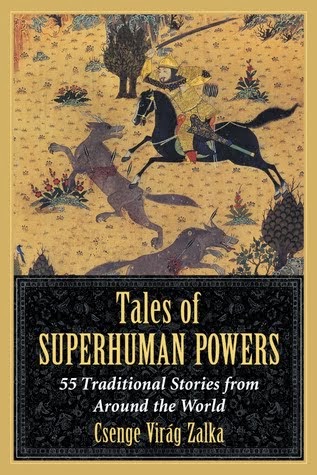Today I continue the blog series titled Following folktales around the world! If you would like to know what the series is all about, you can find the introduction post here. You can find all posts here, or you can follow the series on Facebook!
 Folktales of Bhutan
Folktales of BhutanKunzang Choden
White Lotus Press, 1995.
The book contains 27 folktales and 11 legends. The foreword was written by a Bhutanese princess who praises the book for being the country's first folktale collection. A second foreword talks about the author's childhood, storytelling memories, and the unique features of the Bhutanese oral tradition - for example, that the audience has to say "and then" periodically, or the spirits will steal the tale. I also liked that in their original language tales are not told, but "released" or "unraveled".
The book's introduction talks about the history, culture, and geography of Bhutan, and includes a map. At the end there is a glossary explaining the Bhutanese terms that appear in the tales.
Highlights
I found a classic cumulative tale in a version that I could finally get behind - mostly because it was about stories. Bhutanese tales begin with Dangbo, dingbo (or, if they happened long ago, dangboooo, dingbooo). According to this story, Dingbo keeps chasing Dangbo, but he can never catch up, or stories would disappear from the world. Dangbo steps in a thorn, and he asks for help from a series of entities, before the thorn is finally pulled and he can keep running...
Acho La La was a pretty great magic flight tale where a girl escaped from a monster's house with the help of an old dog and a louse. She kept tossing back seeds to create forests, until the (somewhat lazy and slow) Moon threw her a rope, and she climbed up into the sky. In the story of Bum Sing Sing Yangdonma another girl was also captured by a monster, and did not only escape disguised as an old woman, but also managed to find herself a kind and caring husband. Among the many memorable monsters, the most disgusting was the ghost with the water goiter; if not checked with fire, the goiter kept growing until it exploded and flooded everything. (Ew.). Another creepy creature was the rolong, a sort of Bhutanese zombi, with limbs locked in rigor mortis and a mouth full of maggots. Also, the stewa rutu, an octopus-like water creature who sucks people's blood through their shadow. In one story it was captured with an elephant as bait. In another, it was found as a shriveled up piece of meat, but when someone tried to cook it, it revived and ate people.
There was also a chillingly realistic tale about a girl devoured by a python, who managed to cut herself free.
There was a "faithless mother" tale, which is a tale type I generally hate, but this one managed to be interesting. A mother helped a spirit against her son - but only because the spirit convinced her it was an innocent mortal that the son tried to kill. In the end she found out the truth and regretted her actions.
Of course there would be no Himalayan collection without abominable snowman legends. Here, we had the large and shaggy migoi, and also the smaller, mischievous mirgola.
Connections
The most surprising find: after Switzerland I once again found a tale about a man spending time in the cave of a hibernating dragon. He survives on dragon milk until the creature wakes up and shows him the way out. I wonder what the connection is...
The tale of Dawa Zangpo was a classic magic ring (Aladdin) story; here a cat, a dog, and a monkey helped the hero get the ring back. Interestingly, the story of the wife and husband swapping work here featured a hen and a monkey - and in the end, in a move not unlike the Brementown musicians, the hen got rid of the lazy monkey. There were kind and unkind girls rewarded by a mouse (Aming Niwa), magic tablecloth (The magic phob), and a Fortunatus-tale about a poor boy and flowers that turned his evil wife into a monkey. There was a strange animal bridegroom story where the groom was a goat tail. His wife burned his animal skin too soon - so in their magic home every object ended up having a small flaw. The role of puss-in-boots was played by a lame monkey.
Nyala Lungma, the woman who washes the innards of people who are bound to die soon, reminded me of the Celtic washerwomen doing the same with heroes' clothes. The legend of Nyala Dermo reminded me of fairy midwife tales: here, a female shaman was asked by a spirit to cure her son... a spirit-son who became sick when he was exorcised from a human.
Among the tricksters there was a frog who made a tiger believe it regularly eats tigers.
Where to next?
Taking a big jump to Japan!









Bhutan close to India.
ReplyDelete